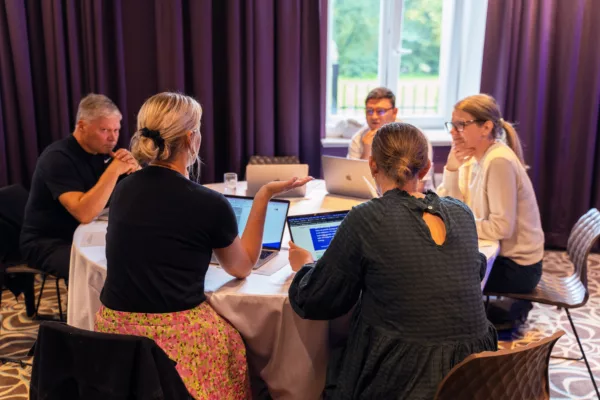
How to become a better leader: 7 tips for effective leadership
With the rise of hybrid and remote work, you might feel that it’s more difficult than ever to be an effective leader today. Coordinating with employees takes more effort when people have more flexibility in their working days. Remote workers can feel neglected and like “second-class” employees due to leaders’ unconscious proximity bias. How can you be the effective leader your employees need?
The new era of work definitely brings some challenges, but it also gives us great opportunities. For one, organizational change can actually become more collaborative. The pandemic has accelerated pre-existing trends like virtual meetings and collaborative online workspaces. Very quickly, we’ve all had to become near-experts in online collaboration, and these ways of working aren’t going anywhere.
As Howspace’s Customer Success Manager, I’d like to share with you some of my best tips for effective leadership. If you play your cards right as a leader, you’ll keep employees feeling valued, significant, and engaged every step of the way.
1. Move away from traditional hierarchy
Modern organizations cannot grow and improve with a top-down management approach. Our new era of work demands a collaborative leadership model that values inclusion at every level.
Employees gain lots of valuable experience and knowledge throughout their roles, and it would be a mistake to ignore their insights when making decisions. In today’s hybrid-working world, we need to leverage the collective brainpower to make the greatest impact.
When employees are involved in organizational processes, their work becomes more meaningful. Rather than just following decisions made at the top, they become a part of the transformation process, which boosts their motivation to contribute.
The outcome of your processes will always be better when you involve people. You get better ideas when you invite people to share their insights and experiences, and you also reduce employees’ resistance to change.
2. Co-create the journey
With large projects like organizational change management or training programs, it doesn’t make sense to have just one or two people package their knowledge and lecture it to others.
Leaders don’t hold the sole nugget of wisdom. Instead, it’s up to leaders to find multiple nuggets of wisdom in the organization by inviting everyone to share their knowledge and experiences. In this way, you can co-create the journey and make smart decisions together, based on everyone’s input.
3. Adapt your strategy to the context
No situation, change process, or context is the same. That’s why there’s not one change strategy that works for every situation. What works for one organization might not work for another.
Keep in mind that when leading change in an organization, you’re not leading a democracy. There will always be someone making a strategic decision and setting the direction for change. The difference today is that you need to take a collaborative leadership approach. Rather than think you have all the answers and tell people what to do, you want to actively listen to all voices within the organization and steer the transformation process.
In any organizational process, you have to find the balance between telling, selling, and involving.
4. Give feedback by example
To be an effective leader, both giving and receiving feedback is important. What the best facilitators and the best leaders have in common is great listening skills.
To feel safe and secure in giving feedback, you have to practice. Start giving feedback to your employees and think about what it means to you and to them. How can you give feedback in a way that makes the recipients feel good about themselves and feel safe to talk openly with you in the future?
There’s no need to wait for someone to do something out of the ordinary to give them positive feedback. In doing so, you’ll make people feel that what they do in their everyday work is seen and makes a difference.
Keep in mind that it’s in our nature to react strongly to criticism due to our basic need to belong to a group, and not be excluded. Even helpful criticism can trigger our “fight or flight” response. When giving both positive and constructive feedback, make sure to be specific so the person can build on what they’re doing well, and identify areas to improve.
To create a true culture of communication, ask for feedback in return. If someone is hesitant to give you constructive feedback, try asking specific questions. For example, during a change process, you could ask employees “How do you think I could get even more people involved?”
5. Learn how to facilitate
Facilitation is about helping a group reach its common objectives. A facilitator does not give a group the correct answers, but is there to help the group find those answers together.
The result of a collaborative process is ownership: People support what they have created together. For a leader, it’s better that employees feel a joint ownership of a change they need to implement since they’ll feel more invested and motivated to make the change.
The best processes are facilitated by a person who is neutral to the outcome. While leaders today should act as facilitators, keep in mind that as a manager, you won’t always be completely neutral. You might already have a view on where the organization should be headed and what should be done.
That being said, facilitating is still an important part of being a leader. You need to ask the right questions, listen to the answers (even the ones you don’t like), and move the process forward. You don’t want to constantly push forward your own arguments. Instead, be open to the input you get and to the fact that your initial view may look different from another angle.
6. Pay attention to how you respond to employees
If you want to engage people in any form of change or development, you have to build trust. No matter how friendly and open you consider yourself to be, there will always be an element of power structure between you and your employees. They may also have a history with low trust relationships that doesn’t have anything to do with you, but affects your leadership. And it may very well affect what people feel safe to share with you.
Pay careful attention to how you respond to employees’ input, questions, concerns, and ideas. In every situation, you always want to thank people for sharing, as it takes courage to do so. Make sure your employees feel heard and comfortable sharing their thoughts and feedback with you.
Taking action on people’s suggestions will also help to earn their trust. And even if you don’t implement their ideas, take the time to help them understand why.
7. Understand the true meaning of dialogue
The definition of dialogue is a discussion or conversation where both parties try to understand each other. However, this is not always the case in workplace discussions between leaders and employees.
Some leaders talk about the importance of dialogue, but what it means in reality is that employees are simply allowed to openly ask questions. In such situations, there can be a tendency for both parties to defend their standpoints without trying to understand each other.
If there has been a true dialogue, both parties walk away feeling that the other made an effort to understand their perspective. They both feel that they have learned something from each other. This creates a trusting relationship, and increased mutual understanding.
Use collaboration platforms the right way
Technology has gone from a supporting role to a central role in recent years. To evolve as an efficient leader and foster a culture of collaboration, you need to leverage the right tools.
Using an online collaboration platform like Howspace can help you foster involvement and dialogue, but it’s how you use it that matters.
If you use Howspace simply for data collection or as a reporting tool, you create a dead end as the information doesn’t flow. You’ll create a closed system, and closed systems cannot develop.
To foster culture and reshape how work happens, bring everyone together on Howspace and give them a role in creating impact. In this way, you’ll arrive at decisions that drive progress and empower employees to feel competent and important.
Interested in learning more about leading change? Download our free guide on How to effectively implement organizational change in a digital environment.
You might be interested in these as well
View all
Make Your Decision-Making More Inclusive and Effective
Participatory decision-making taps into the collective wisdom of your entire workforce. Here’s how to make more impactful decisions in your organization.

The best change management tools for successful organizational transformation
Embracing change within organizations can be challenging, as people naturally resist it. However, utilizing the right change management software can […]

Top 7 Virtual Organizational Transformation Strategies
When it comes to organizational transformation strategies and how to effectively lead change in a virtual environment, my pro tip […]